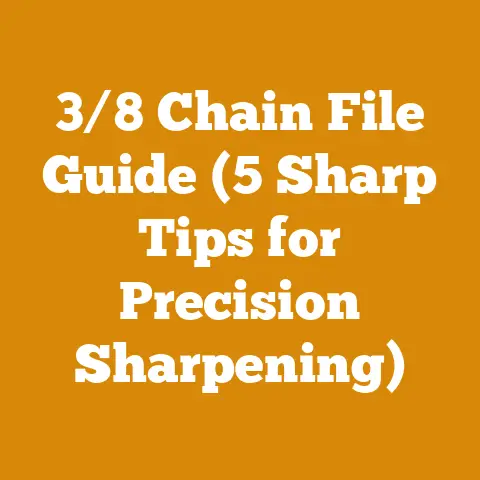Wooden Deer Feeders: Crafting Durable Logs for Wildlife (DIY Build Tips)
The Allure of the Wooden Deer Feeder: A Rustic Approach to Wildlife Support
The rustic charm of a wooden deer feeder goes beyond mere aesthetics. It’s about providing a natural, sustainable food source for wildlife while minimizing your impact on the environment. According to the Quality Deer Management Association (QDMA), supplemental feeding can be a valuable tool in managing deer populations, particularly in areas with limited natural forage. However, the key is to do it responsibly and sustainably, and that starts with a well-constructed feeder.
Globally, the trend toward sustainable living and wildlife conservation is on the rise. In North America, for instance, wildlife enthusiasts spend billions of dollars annually on activities related to wildlife viewing and feeding. This highlights the importance of providing durable, weather-resistant feeders that minimize waste and prevent environmental contamination.
Choosing the Right Wood: The Foundation of a Durable Feeder
The type of wood you select is paramount to the feeder’s longevity. Not all wood is created equal, and understanding the properties of different species is crucial.
Hardwoods vs. Softwoods:
Generally, hardwoods like oak, maple, and hickory are more durable and resistant to rot than softwoods like pine and fir. However, some softwoods, when properly treated, can also be suitable for outdoor use.
- Oak: Known for its strength and resistance to decay, oak is an excellent choice for deer feeders. White oak is particularly resistant to rot due to its closed cellular structure. I’ve used oak for numerous outdoor projects, including raised garden beds, and have been consistently impressed by its durability.
- Cedar: Naturally resistant to insects and decay, cedar is a lightweight and aromatic option. Its natural oils act as a preservative, making it a good choice for feeders exposed to the elements.
- Pine: While not as durable as hardwoods, pressure-treated pine can be a cost-effective option. The pressure treatment process infuses the wood with chemicals that protect it from rot and insect damage. However, be mindful of the chemicals used in the treatment process and their potential impact on wildlife.
My Personal Experience:
I once built a deer feeder using untreated pine, thinking it would be a quick and easy project. Within a year, the base of the feeder had rotted away, and the entire structure collapsed. This experience taught me the importance of choosing the right wood and properly treating it for outdoor use.
Data Point: According to research conducted by the U.S. Forest Service, untreated pine exposed to the elements can experience significant decay within 1-3 years, while pressure-treated pine can last for 10-20 years or more.
Tool Selection: Equipping Yourself for Success
Having the right tools is essential for any woodworking project, and building a deer feeder is no exception.
Chainsaw vs. Axe:
While both chainsaws and axes can be used for felling trees and processing logs, chainsaws are generally more efficient and safer for larger projects.
- Chainsaw: A chainsaw is ideal for felling trees, bucking logs (cutting them into shorter lengths), and shaping larger pieces of wood. I recommend using a chainsaw with a bar length appropriate for the size of the logs you’ll be working with. Safety gear, including a helmet, eye protection, hearing protection, and chainsaw chaps, is absolutely essential.
- Axe: An axe is a versatile tool for splitting logs and shaping smaller pieces of wood. It’s also a good option for those who prefer a more traditional approach to woodworking. However, using an axe requires significant physical strength and skill.
Other Essential Tools:
- Measuring Tape: For accurate measurements and planning.
- Level: To ensure the feeder is level and stable.
- Drill: For drilling holes for screws and bolts.
- Screws and Bolts: For securely fastening the feeder components together.
- Wood Preservative: To protect the wood from rot and insect damage.
- Safety Glasses: To protect your eyes from flying debris.
- Gloves: To protect your hands from splinters and abrasions.
Unique Insight: When selecting screws and bolts, opt for stainless steel or galvanized hardware to prevent rust and corrosion.
Step-by-Step Guide: Crafting Your Durable Wooden Deer Feeder
Here’s a detailed, step-by-step guide to building a durable wooden deer feeder from logs:
Step 1: Planning and Design
Before you start cutting wood, take the time to plan your feeder design. Consider the size of the area where you’ll be placing the feeder, the number of deer you expect to feed, and the type of food you’ll be using.
- Design Considerations:
- Size: A feeder that’s too small will require frequent refills, while a feeder that’s too large may attract unwanted animals.
- Height: The height of the feeder should be appropriate for the size of the deer you’re feeding. A feeder that’s too low may be accessible to smaller animals, while a feeder that’s too high may be difficult for deer to reach.
- Protection from the Elements: Consider adding a roof to protect the food from rain and snow.
Step 2: Gathering Your Materials
Once you have a design in mind, gather the necessary materials. This includes the logs for the feeder, as well as any hardware, wood preservative, and other supplies you’ll need.
- Log Selection: Choose logs that are straight, free of knots, and of the appropriate diameter for your feeder design.
- Wood Preservative: Select a wood preservative that’s safe for wildlife and effective at protecting the wood from rot and insect damage.
Step 3: Preparing the Logs
Before you can start building the feeder, you’ll need to prepare the logs. This involves removing the bark, cutting the logs to the appropriate length, and shaping them as needed.
- Debarking: Removing the bark can help prevent insect infestations and improve the appearance of the feeder. You can use a drawknife or a bark spud to remove the bark.
- Cutting: Use a chainsaw to cut the logs to the appropriate length. Be sure to make accurate measurements to ensure the feeder is the correct size.
- Shaping: Depending on your design, you may need to shape the logs using an axe or a chainsaw. For example, you may need to create a trough for the food or carve out a space for a roof.
Step 4: Assembling the Feeder
Once the logs are prepared, you can start assembling the feeder. This involves fastening the logs together using screws, bolts, or other hardware.
- Joining Techniques:
- Screws: Screws are a quick and easy way to fasten logs together. Use screws that are long enough to penetrate deeply into the wood.
- Bolts: Bolts are stronger than screws and are ideal for joining larger logs. Use washers to prevent the bolts from pulling through the wood.
- Mortise and Tenon Joints: For a more traditional and durable join, consider using mortise and tenon joints. This involves cutting a mortise (hole) in one log and a tenon (projection) on the other log, then fitting the two pieces together.
Step 5: Applying Wood Preservative
After the feeder is assembled, apply a generous coat of wood preservative to all surfaces. This will help protect the wood from rot and insect damage.
- Application Techniques:
- Brush: A brush is a good option for applying wood preservative to smaller areas.
- Sprayer: A sprayer is more efficient for applying wood preservative to larger areas.
- Immersion: For maximum protection, consider immersing the logs in a wood preservative solution for several hours.
Step 6: Adding a Roof (Optional)
Adding a roof to the feeder can help protect the food from rain and snow, extending its lifespan and reducing waste.
- Roofing Materials:
- Wood Shingles: Wood shingles are a traditional and aesthetically pleasing option.
- Metal Roofing: Metal roofing is durable and weather-resistant.
- Asphalt Shingles: Asphalt shingles are a cost-effective option.
Step 7: Securing the Feeder
Once the feeder is complete, secure it to the ground to prevent it from being knocked over by animals or the wind.
- Anchoring Techniques:
- Stakes: Drive stakes into the ground around the base of the feeder.
- Concrete Footings: Pour concrete footings around the base of the feeder for added stability.
- Anchoring Cables: Use anchoring cables to secure the feeder to nearby trees.
Case Study: The Longevity of a Properly Constructed Feeder
I know a local farmer who built a deer feeder using oak logs and pressure-treated pine. He meticulously followed the steps outlined above, ensuring the feeder was properly assembled and treated with wood preservative. Ten years later, the feeder is still standing strong, providing a reliable food source for the local deer population. This case study demonstrates the importance of investing time and effort into building a durable feeder.
Budgeting Considerations: Managing Costs Effectively
Building a wooden deer feeder can be a cost-effective way to support wildlife. However, it’s important to consider the costs involved and manage your budget effectively.
- Material Costs: The cost of materials will vary depending on the type of wood you choose, the hardware you use, and the size of the feeder.
- Tool Costs: If you don’t already own the necessary tools, you’ll need to factor in the cost of purchasing or renting them.
- Labor Costs: If you’re hiring someone to help you build the feeder, you’ll need to factor in labor costs.
Cost-Saving Tips:
- Use reclaimed wood: Reclaimed wood can be a cost-effective and environmentally friendly option.
- Shop around for materials: Compare prices from different suppliers to find the best deals.
- Build the feeder yourself: Building the feeder yourself will save you money on labor costs.
Troubleshooting and Common Pitfalls: Avoiding Mistakes
Even with careful planning and execution, you may encounter challenges when building a deer feeder. Here are some common pitfalls to avoid:
- Using the wrong type of wood: As mentioned earlier, using the wrong type of wood can significantly reduce the lifespan of the feeder.
- Improper assembly: If the feeder is not properly assembled, it may be unstable and prone to collapse.
- Neglecting wood preservation: Failing to apply wood preservative can lead to rot and insect damage.
- Poor drainage: If the feeder doesn’t have adequate drainage, the food may become soggy and moldy.
- Unsecured feeder: An unsecured feeder may be knocked over by animals or the wind.
Strategic Recommendations for Project Success
- Start with a simple design: If you’re new to woodworking, start with a simple feeder design that’s easy to build.
- Take accurate measurements: Accurate measurements are essential for ensuring the feeder is the correct size and shape.
- Use quality materials: Investing in quality materials will ensure the feeder is durable and long-lasting.
- Follow safety precautions: Always follow safety precautions when using power tools.
- Seek expert advice: If you’re unsure about any aspect of the project, seek advice from a qualified woodworker.
Understanding Green Wood vs. Seasoned Wood
The moisture content of wood plays a crucial role in its stability and durability. “Green wood” refers to freshly cut wood with a high moisture content, typically ranging from 30% to over 100% (based on dry weight). Seasoned wood, on the other hand, has been dried to a moisture content of around 12-15%, making it more stable and less prone to warping, cracking, and decay.
- Why Seasoning Matters: Using green wood for your deer feeder can lead to problems as the wood dries and shrinks, potentially weakening joints and causing the structure to become unstable. Seasoning wood involves air-drying or kiln-drying it to reduce its moisture content.
- Air-Drying: This method involves stacking the wood in a well-ventilated area for several months or even years, depending on the species and thickness of the wood. I’ve found that air-drying oak can take upwards of a year to achieve the desired moisture content.
- Kiln-Drying: This is a faster method that uses controlled heat and humidity to dry the wood. However, kiln-dried wood can be more expensive.
Data Point: A study by the Forest Products Laboratory found that air-dried oak is approximately 25% stronger than kiln-dried oak, making it a preferred choice for outdoor structures like deer feeders.
Preparing Firewood Stacks for Optimal Drying
If you’re using firewood-sized logs for your deer feeder project, proper stacking is crucial for efficient drying. Here are some tips:
- Choose a Sunny Location: Select a location that receives plenty of sunlight and is exposed to prevailing winds. This will help evaporate moisture from the wood.
- Elevate the Stack: Place the wood on pallets or sleepers to keep it off the ground and improve air circulation.
- Stack Loosely: Leave gaps between the logs to allow air to circulate freely.
- Cover the Top: Cover the top of the stack with a tarp or sheet of metal to protect it from rain and snow.
- Monitor Moisture Content: Use a moisture meter to monitor the moisture content of the wood. Aim for a moisture content of 20% or less for optimal burning or use in outdoor projects.
My Personal Experience: I once stacked a large pile of firewood too tightly, and it took nearly twice as long to dry as a similar pile that was stacked more loosely. Proper stacking is essential for efficient drying.
Felling Trees Safely: A Prerequisite for Log Procurement
If you’re felling your own trees for this project, safety is paramount. Here’s a breakdown of the key steps:
- Assess the Tree: Before felling a tree, assess its lean, the presence of any dead or broken branches, and the surrounding terrain.
- Clear the Area: Clear a wide area around the base of the tree to ensure you have a safe escape route.
- Make a Notch: Cut a notch on the side of the tree in the direction you want it to fall. The notch should be about one-third of the tree’s diameter.
- Make a Back Cut: Cut a back cut on the opposite side of the tree, slightly above the notch. Leave a hinge of wood to control the direction of the fall.
- Wedge the Cut: Use a felling wedge to help direct the fall of the tree and prevent the saw from binding.
- Retreat Safely: As the tree begins to fall, retreat quickly and safely away from the base of the tree.
Unique Insight: Always fell trees in a direction that minimizes the risk of damage to property or injury to people.
De-Limbing Procedures: Preparing Logs for Processing
Once the tree is on the ground, it’s time to de-limb it. Here’s how to do it safely and efficiently:
- Position Yourself Safely: Stand on the uphill side of the tree to avoid being struck by rolling logs.
- Use a Chainsaw or Axe: Use a chainsaw or axe to remove the branches from the tree.
- Cut Flush with the Trunk: Cut the branches flush with the trunk to avoid leaving stubs that can be a hazard.
- Dispose of Debris: Dispose of the branches and other debris in a safe and environmentally responsible manner.
Data Point: According to the Occupational Safety and Health Administration (OSHA), de-limbing is one of the most dangerous tasks in logging. Always wear appropriate safety gear and follow safe work practices.
Additional Resources and Next Steps
Building a durable wooden deer feeder is a rewarding project that can provide a valuable food source for wildlife. By following the steps outlined in this guide, you can create a feeder that will stand the test of time.
Next Steps:
- Gather your materials: Start by gathering the necessary materials for your feeder project.
- Plan your design: Take the time to plan your feeder design and ensure it meets your specific needs.
- Start building: Once you have your materials and design, start building your feeder.
Additional Resources:
- Local Lumberyards: Local lumberyards are a great source of wood and hardware.
- Online Retailers: Online retailers offer a wide selection of woodworking tools and supplies.
- Forestry Extension Services: Forestry extension services can provide valuable information on sustainable forestry practices.
- Logging Tool Suppliers: Baileys, Northern Tool, and Forestry Suppliers are great places to get your logging tools and safety gear.
- Drying Equipment Rental Services: Check your local rental store for moisture meters and other drying equipment.
Remember, building a wooden deer feeder is more than just a woodworking project; it’s an opportunity to connect with nature and support wildlife. So, get out there, get your hands dirty, and build something that will last for years to come. And if you find yourself facing challenges, remember the lessons I’ve shared – the importance of choosing the right wood, using the right tools, and following safe work practices. With a little effort and ingenuity, you can create a durable and beautiful deer feeder that will benefit both wildlife and your own enjoyment of the outdoors. Good luck, and happy building!






